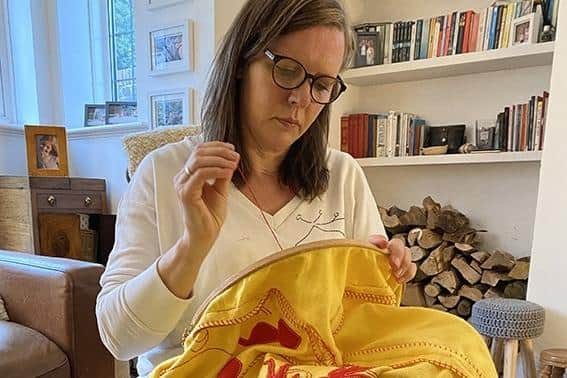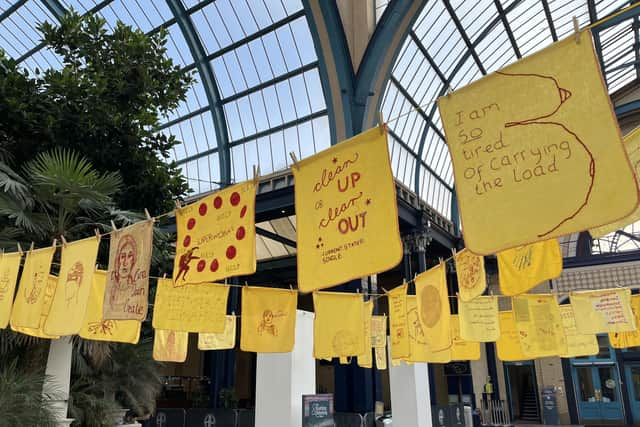How the humble yellow duster has been transformed into art exploring domestic work
Her Domestic Dusters collaborative arts project invites women to embroider their domestic experiences, complaints, and celebrations as words or images on to a yellow duster. It showcases a selection of dusters that have been embroidered by women from across the world, challenging the legacy of so-called women’s work.
Nearly ten years ago, Marr came up with the idea of using dusters as a way of expressing women’s thoughts on domestic work. “When I first began this project, I could never have anticipated the reach it would have nor the opportunities that have arisen from it,” says Marr, who has a background in graphic design before becoming a textile artist and academic based at the University of Brighton.
Advertisement
Hide AdAdvertisement
Hide AdShe is bringing the exhibition of around 100 of the dusters – around a third of the number she actually has – to the Knitting and Stitching Show in Harrogate this month. “When I started I didn’t want to curate the collection, but now there is no way I could show all of the ones I have received over the years which I keep in a chest of drawers at home and so I do have to select the ones to show which is never easy although I tend to include some old favourites, new ones I have received and also, to some extent, take into account the audience who will see them.


“I have met so many amazing women. Most duster submissions come with a note telling the stitcher’s story. They give insight into the lives of these women, whom despite assumptions are not usually those who have the time to embroider a duster; it is much more likely that they don’t but that they feel driven to because they need their voices to be heard.”
Some of the stories are included in shows but many are not, mainly because Marr wants viewers to come to their own conclusion but also as many of the stories are deeply private.
“I do make a point of working with those whose domestic situations are compromised through violence, enforced migration, unpaid caring responsibilities or homelessness, which rarely join the exhibited collection because of their necessarily private nature, but nonetheless share the domestic legacy. It is very humbling.”
Advertisement
Hide AdAdvertisement
Hide AdShe often works with groups of women, as part of her research explores how the very act of embroidering the dusters collectively has a sometimes ‘magical’ effect on the participants.


From America to New Zealand, across to Australia then back via Europe, the stories held within the stitches of the dusters from across the world echo similar themes. They include frustration, celebration, humour, sometimes anger, but also fond memories of mothers, stories of family and discussions of home and what it means to be a woman today.
“I’ve discovered that the duster is well-known in the UK, some parts of Europe and Australia, less so in America, New Zealand, or India. This has led to other domestic cloths occasionally joining the collection, which nonetheless represent the same thing – invisibility, mundaneness, lack of value and domesticity.”
Marr aims to raise the voices of women and their roles in the home across the world and through the years, through her art. “My research with the dusters has revealed that in early societies women often worked this way for practical reasons, whilst simultaneously running the home and childrearing, because it’s a task that can fit around other responsibilities,” explains Marr.
Advertisement
Hide AdAdvertisement
Hide Ad“When I stitch my dusters, I can almost feel my foremothers over my shoulder, juggling it all just as we do now, which hugely inspired my own creative methodology. Over the centuries, as the public and private spheres of society divided to place women firmly in the private space of the home, their opportunities diminished, and it was often used as a tool to keep them under control.
“More positively, however, it was also one of the few ways that women could earn a living and a limited avenue for literacy, so its subversion as a tool for emancipation is a way of referencing the past whilst striving for a fairer future. I selected a duster because it is a cleaning cloth that is commonplace in the UK, and therefore provides both an immediate visual reference to its purpose, and the context for my subsequent discussion of domesticity.
“It is also a cloth that is mundane , of low monetary value, with a lowly status that likely relegates its place in the home to the domestic cleaning cupboard. Conversely, it is striking in its vibrant yellow, pleasurably soft to touch, and when embellished with embroidery it is transformed into a beautiful object,” says Marr.
“I use the academic research to inspire and underpin my creative work, but likewise have a strong desire to make whilst I’m writing...I often include embroidery or creative writing within my published papers and book chapters, not as illustrations but as responses in their own right.”
Advertisement
Hide AdAdvertisement
Hide AdOn a personal note, Marr says she finds textile art, particularly embroidery, mindful, which takes her to a calm space allowing her mind to roam. She says she learnt to knit and sew as a small child thanks to her mother and grandmother, but when she went to university to study graphic design textiles became little more than a hobby. It was while studying for an MA as a mature student in 2012 that Marr brought her two loves together.
Vanessa Marr’s collaborative art project Women & Domesticity – What’s Your Perspective? is at The Knitting and Stitching Show at Harrogate Convention Centre on November 16. For tickets, www.theknittingandstitchingshow.com/harrogate